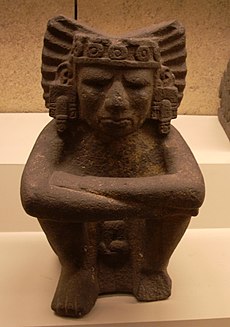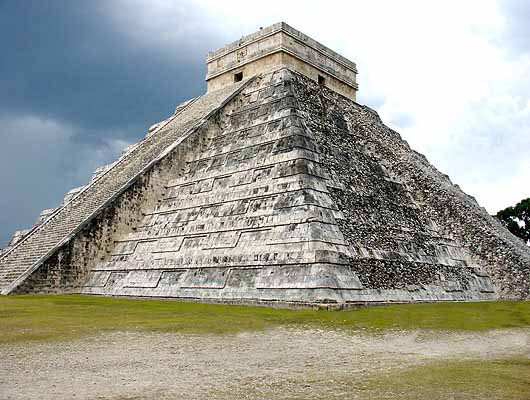The underworld is known as Mictlan, and in some mythical accounts is placed in the north, but it is often referred to as being underground. Souls who had just arrived to the underworld had to face a series of tests and challenges. First they were required to cross a raging river. After that they had to find a way between two clashing mountains. They then had to climb a mountain made of obsidian. Obsidian is sacred to dark Tezcatilpoca. While climbing they had to face an icy wind that was so cold it could peel the flesh off your face. Sounds terrifying and also slightly like the 9 circles of hell. They had to defeat a snake, an alligator, survive crossing 8 deserts and climb to the top of 8 mountains.
 |
| Mictlantecuhtli, Lord of the Underworld |
 |
| His wife Mictecacihuatl |
Mictlantechuhtli governed over all 3 types of souls, normal deaths, heroic deaths (battle, sacrifice, childbirth), and non-heroic.
Mictlantechuhtli and his wife are opposites/compliments of Ometecuhtli and Omecihuatl, givers of life. Which makes me think of Yin and Yang.
Upon death, the dead are buried with grave goods and upon entering they offered them to Mictlantechuhtli and his wife to try and get in their favor.
"From the sun god Tonatiuh came heat and light, from the clouds sent by the rain god Tlaloc and blown into place by Quetzalcoatl (in his manifestation as the wind god Ehecatl) fell the waters that gave life to the maize crop." (Ancient Civilizations, The Aztecs) The Aztecs believed human life was part of a cosmic movement of energy. In the Nahuatl language, the word for sacrifice was uemmana. Uemmana combines mana, which means to pass on and ventli means offering. Sacrifices were how the Aztecs returned life energy to its source, which is necessary to maintain the cycle of energy. Blood was the water of life, and was the god's favorite offering. The most common public form was to rip the victim's heart from their chest on a sacrificial stone. The stone was called quauhxicalli, eagle stone, and the victims were spread-eagle on top of it. The stone was shaped in a way that forced the victim's body to arch back and force the chest upwards towards the tecpatl, sacrificial knife. The ritual required 6 priests. Four of them held the victim down, the 5th seized throat, and the 6th sliced and grabbed the heart. He would hold the heart up to the sun before throwing on God's image. The body was then threw down the steps and they generally sacrificed multiple victims so there was a huge pile of corpses.
Other type of sacrifice was autosacrifice. They used volcanic glass, obsidian, or spines of cactus to cut themselves. Or they even drew cord of thorns across their penis or tongue. They sometimes soaked blood in bark paper before their offering.
There was also burning to honor the fire god Xiuhtecuhtli. They would celebrate Xipe Totec, Our Flayed Lord, god of vegetation and new plants. The victim was shot with arrows, allowed to collapse on ground while blood ran out of the body. It makes me think of life-giving rain. Once the body finally bled dry, it was fayed and the skin was worn by a young man in a ritual that resembles a fresh plant sprout emerging from a husk of old.
Victims were commonly prisoners of war. They went to their deaths as messengers to the gods. In some circumstances they were viewed as earthly representations of the gods, called ixiptla, which means likeness of the gods. The gods were visible to the viewing crowd as they became one with the victims.
They also honored Chalchiuhtlicue, the goddess of rivers. A young woman, viewed as ixiptla, was put to death during the festival of Huey Tozoztli in Lake Texcoco. Her blood was collected and poured into water.
At the festival of Toxcatl, an earthly form of Tezcatlipoca was slain. Tezcatlipoca was associated with a wide range of things:
 |
| Obsidian Rock |
 |
| Xiuhtechuhtli, the Fire God |
Victims were commonly prisoners of war. They went to their deaths as messengers to the gods. In some circumstances they were viewed as earthly representations of the gods, called ixiptla, which means likeness of the gods. The gods were visible to the viewing crowd as they became one with the victims.
They also honored Chalchiuhtlicue, the goddess of rivers. A young woman, viewed as ixiptla, was put to death during the festival of Huey Tozoztli in Lake Texcoco. Her blood was collected and poured into water.
At the festival of Toxcatl, an earthly form of Tezcatlipoca was slain. Tezcatlipoca was associated with a wide range of things:
- night sky
- nigh winds
- north
- earth
- obsidian
- enmity
- discord
- rulership
- divination
- temptation
- jaguars
- socery
- beauty
- war and strife
He was also known as Smoking Mirror, which connects to the volcanic glass, obsidian, because it is the materials mirrors were made form and they were used for shamanic rituals. To me, obsidian appears to be a huge part of Aztec sacrifice.
 |
| Tenochtitlan's Great Pyramid |
The Aztecs also made animal sacrifices including quails, dogs, turkeys and jaguars. Jaguar bones were actually found in the foundations of the Great Pyramid in Tenochtitlan. Jaguars were worshipped as a symbol of kingly power and fertility. It's interesting that the Aztecs went so far as to put them inside of their structures.
Looking past sacrifices and moving onto Aztec burials. Most Aztecs were actually cremated. They were generally clothed very nicely, bound in a squatting position and wrapped in cloth before being burned. Rulers and nobility were buried in a stone vault. The creepy thing is that sometimes the noble's wife or servants were killed just to be buried with him at death. It reminds me of the Ancient Egyptians and their servant burials. They also buried many servants with their Kings at one point in their history.
Sometimes a man was entombed or burned with a living dog. The dog was expected to be a useful guide in the underworld. It was a reminder of the voyage to Mictlan by Quetzalcoatl and his dog-double, Xolotl.
The dead were buried/burned with goods that would help in their travels in Mictlan, such as:
- food
- water
- blankets
- a jade bead to act as a heart
- paper
- clothes
- and grave goods to act as presents to the underworld lords
A few accounts say the souls of the dead find peace of extinction after their initial trials through Mictlan. But other accounts suggest they suffer eternally and find relief only one day a year, the Day of the Dead. Which is still celebrated today as the day the souls come back and mingle with the living.
There is a version of Mictlan described in a codex of Quetzalcoatl's voyage at the beginning of the age. Quetzalcoatl went down to Mictlan by passing through the body of the earth goddess Coatlicue first. Then he traveled east of Mictlan and cremated himself on a pyre and his body was remade in the form of a flock of birds. In that form he traveled south, and is said to have died by beheading or dismemberment. He then passed without injury through the body of goddess Tlazolteotl,. He found two temples in the west, one that contained the souls of women who died during childbirth and the other that contained other warrior souls. He then passed through the earth monster Tlatelcuhtli and split into Red Quetzalcoatl and Black Quetzalcoatl. He finally made it into the north and sacrificed his Red Quetzalcoatl and threw himself, Black Quetzalcoatl, onto a sacrificial pyre. His spirit rose from Mictlan to the heavens and was known there as Venus, the Morning Star.
 |
| Quetzalcoatl |
Quetzalcoatl means feathered serpent. He is a deity related to Gods of the Wind, of Venus, of dawn, of merchants, of arts and crafts and of knowledge. he is the patron god of priesthood, of learning and knowledge. He is included among important gods of Aztec Pantehon.
The Aztecs also took a great stake in death, as many ancient cultures did. It intrigues me to know just how many different ways they could make offerings to the gods in blood. It's thought invoking of how much stake they put in their sacrifices to have good crops that year. They just wanted to ensure that the people were provided and looked after. The Aztecs were truly an intriguing culture that we have so much to learn about.
And they say dying is easy, wow, the Aztecs would most certainly disagree. Then after you cross the desert, you have to cross… seven more! Hahahaha! Wait, wait, wait, then you have to climb eight mountains! I imagine failure in these tests would involve your spirit being lost forever, suffering forever, or being feasted upon by some malevolent spirit or powerful god. This attitude towards death would undoubtedly have caused great sadness in many, but also, the desire among the commoners to be the toughest and the strongest they could be, so as to conquer their adversaries in life as well as their challenges in death.
ReplyDeleteThere seem to be several interconnected beliefs about death not just in South America but also across the globe. As you pointed out, the challenges are reminiscent of the nine circles of Hell, which are also reminiscent of the world tree and the plane of Helheim from Norse mythology, and to the dark world of Hades in the Greek mythos. The underworld is something that spans across almost all cultures, and it is not unreasonable to assume that these beliefs stem from the concept of burial, to bury the body within the Earth. That death appears to the living as a sleep, and in our dreams we are able to travel to worlds composed of imagination, far beyond the space of reality.
This is fascinating to think about, and I am sure that more parallels can be found in almost every culture on Earth. As for your post, it is very thought provoking, if a little short, and only one image leaves the reading hungering for more. Overall, it is good, but if you have time to expand on the Aztecs, I would be most interested in reading about them.
I accidently posted it before I was done with it so it's not finished.
Deletecan you comment on your reliability as a secondary source
ReplyDeleteI, too, would like some comments on reliability, as I plan on referencing your work in my school assignment on Aztec beliefs and funerary practices.
ReplyDeleteThanks for this information! It helped me a lot!! :)
ReplyDelete